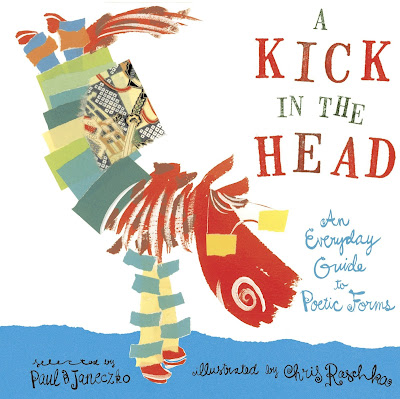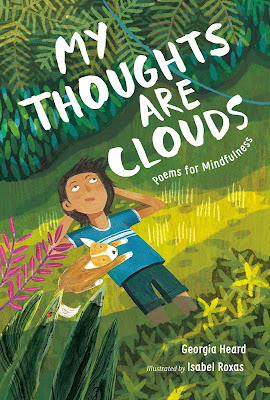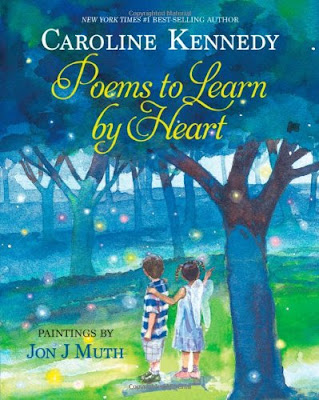A Kick in the Head: An Everyday Guide to Poetic Forms
Bibliography:
Janeczko, Paul B. A Kick in the Head: An Everyday Guide to Poetic Forms. Ill. by Chris Raschka. Somerville, Massachusetts: Candlewick Press, 2009. ISBN: 978-0763641320
Summary:
A Kick in the Head: An Everyday Guide to Poetic Forms is a fun and colorful primer introducing the rules of twenty-nine different styles of poetry. An introduction by the editor, Paul B. Janeczko, explains that rules make “the writing of a poem more challenging and exciting,” comparing them to the rules of games and sports. These limitations can inspire creativity, and Janeczko suggests that readers try their hands at mimicking the poets’ styles, bending the rules, forming poetry clubs, and giving poems as gifts. Each poetic form is introduced with one or two poems from a diverse cast of poets, along with Chris Raschka’s quirky illustrations. Raschka represents the poetic forms in small icons that appear above the names of the forms: a pair of birds for couplets, 5 and 7 and 5 flowers for the haiku, and a bouncing ball matching the rhythmic syllables of the limerick. A footnote on each page defines the rules and rhyme schemes of the poems. A final section, “Notes on the Forms,” gathers all the forms in one place with their names and definitions accompanied by Raschka’s cleverly symbolic icons.
Analysis:
Poetry writers looking for a good challenge will love A Kick in the Head for its humor and clear guidance. Janeczko’s advice inside the front cover encourages readers to experiment and have fun with poetic forms. From the outset, it is clear that this is not a stuffy rule book but rather a zany celebration of puzzles, lists, riddles, and rhymes that have been used by poets for centuries. Shakespearean sonnets appear alongside quatrains by William Blake and contemporary double dactyls by Allan Wolf. Some forms like the haiku, ode, sonnet, and limerick may be familiar to readers, while less common forms like the pantoum, aubade, and villanelle will challenge writers to follow tricky rules explained in the footnotes. Although some poems may be less accessible than others, readers can experiment with simpler forms before trying more complicated constructions.
Many of the poems have humorous subject matter. For example, the clerihew by E.C. Bentley (a pair of rhyming couplets that “poke gentle fun at a celebrity”) rhymes with the name of a well-known writer, “ Edgar Allan Poe / Was passionately fond of roe. / He always liked to chew some / When writing anything gruesome.” An “Ode to Pablo’s Tennis Shoes” by Gary Soto pays tribute to a pair of grass-stained sneakers: “Rain-beaten, sun-beaten, / A scuff of green / At their tips…” Readers will be eager to try out these forms with their own ideas, making this book an excellent resource for dedicated poets and dabbling bards. Rhyme scheme plays an important role in some forms, while others rely on specific numbers of syllables and subject matter. Did you know that a haiku written about human nature, rather than the natural world, is actually called a “senryu”? Kristine O’Connell George writes, “First day, new school year, / backpack harbors a fossil… / last June’s cheese sandwich.”
Chris Raschka’s mixed media illustrations are a highlight of this colorful collection. Bright origami patterned paper is torn and embellished with paint, creating silly characters and creatures with oversized noses and funky hats. The pages are packed with vibrant color and clever depictions of the poems’ subjects. Raschka’s smart icon designs that demonstrate the various forms will help readers recognize and remember what makes each poem unique. The persona poem is labeled with a little blue mask, the epitaph represented with a tiny tombstone, the ode with a Grecian urn, the ballad with a miniature guitar, etc.
A Kick in the Head is an excellent primer for budding poets who want to test their skills by trying out these 29 forms. With patience and practice, writers will expand their poetic toolbox and have a blast creating new variations on old forms. Ages 8-12.
Excerpt:
Double Dactyl
“History Lesson” by Allan Wolf
Higgledy-Piggledy
Wiliam the Conqueror
Ousted King Harold in
Ten Sixty-Six,
Sacked Anglo-Saxons and,
Normanmaniacal,
Cut off their heads and dis-
played them on sticks.
*A dactyl is a three-syllable word or phrase in which the first syllable is accented and the other two aren’t, such as cereal. A double dactyl is a humorous single-sentence poem spread over two quatrains, with two dactyls in most lines. Line 6 or 7 must be a one-word double dactyl, such as antiheroically.
Activities:
- Introduce rhyme scheme by starting with couplets, then graduate to quatrains, and then more challenging and hilarious limericks.
- Display poems and invite readers to identify matching rhymes. Color code rhyming lines for a fun visualization of the poems’ patterns.
- As you introduce more and more forms, hold a poetry contest where poets enter different categories like a swim meet or a track meet. Who will win the 500-meter ballad? Don’t forget to supply the ribbons and medals for the closing ceremonies!




Comments
Post a Comment